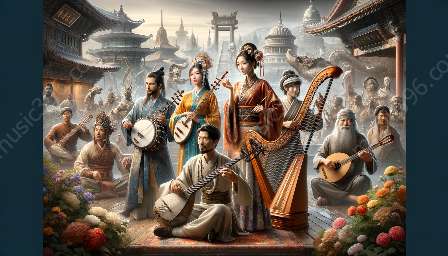Asian music has been deeply influenced by the concepts of time and space, which have shaped the compositions and performances in unique ways. This influence not only resonates within the realm of Asian music but also extends to the broader sphere of world music. Exploring how time and space influence musical expression in Asian cultures reveals a rich tapestry of artistic creativity and cultural significance.
Concept of Time in Asian Music:
The concept of time in Asian music is often cyclical and non-linear. This is evident in traditional East Asian music, where the cyclical nature of time is represented through musical structures that are repetitive and structured around cycles or phases. Time in Asian music is not perceived as a linear progression but rather as a series of interconnected moments, allowing for improvisation and non-linear narrative development.
This non-linear perception of time is also reflected in the rhythmic patterns and temporal structures found in Asian music. For example, Indian classical music often uses intricate rhythmic cycles such as tala, which are based on flexible, cyclical patterns rather than a strict adherence to linear meter. Similarly, the use of free rhythm and non-quantized time in East Asian traditional music reflects a different temporal perspective than that found in Western classical music.
Influence of Space in Asian Music:
The concept of space in Asian music manifests through a deep connection to the natural environment and spiritual landscapes. Many Asian musical traditions are rooted in a profound reverence for nature and the spiritual world, which is expressed through the use of evocative sonic landscapes and the incorporation of environmental sounds into musical compositions.
For example, traditional Asian instruments such as the Chinese guqin or the Japanese shakuhachi are often associated with the contemplation of natural surroundings and the expression of profound emotions related to the human experience of the natural world. The use of space in Asian music goes beyond physical dimensions and encompasses the spiritual, emotional, and metaphysical dimensions of sound.
Impact on Compositions and Performances:
The influence of time and space on Asian music has led to distinct compositional and performance practices that differ from those found in Western music. Compositions often emphasize the exploration of sonic textures, timbral variations, and the creation of immersive sonic environments, reflecting the influence of the natural and spiritual world on musical expression.
Traditional Asian musical performances frequently involve the interplay between performer, audience, and space, creating a holistic sensory experience that blurs the boundaries between music, environment, and ritual. Improvisation and non-linear narrative development are integral to Asian musical performances, allowing for a sense of timelessness and spontaneity that reflects the cyclical nature of time in Asian musical traditions.
Impact on World Music:
The influence of time and space on Asian music has significantly contributed to the diversity and richness of world music. The unique perspectives on time and space found in Asian music have inspired and influenced musicians and composers across the globe, leading to cross-cultural collaborations and the integration of Asian musical elements into diverse musical genres.
Contemporary world music often incorporates elements of Asian musical traditions, embracing non-linear rhythmic structures, the use of natural and environmental sounds, and the exploration of meditative and contemplative sonic experiences. The fusion of Asian and world music has expanded the creative possibilities within the global music landscape, fostering a deeper appreciation for the influence of time and space on musical expression.










































